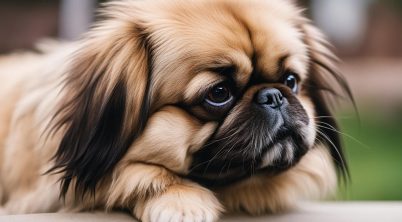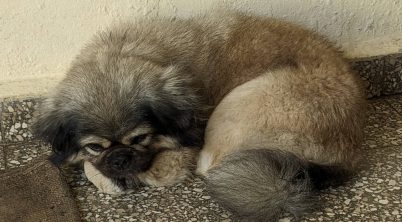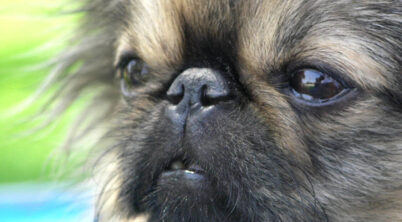The Pekingese breed, with its regal and distinctive appearance, has long been associated with Chinese royalty. Its compact size and affectionate nature have gained the breed a dedicated following. However, categorizing the Pekingese as a dangerous breed would be a misrepresentation. These dogs are generally known for their loyalty and can form a strong bond with their owners. While they may exhibit protective behaviors, they are not characteristically aggressive toward people.
It is important to consider the temperament of individual dogs rather than attributing blanket characteristics to an entire breed. The Pekingese may exhibit standoffish behavior with strangers or show assertiveness in certain situations, which is often a manifestation of their self-assured nature. Despite their small stature, they carry a self-important demeanor which sometimes could be mistaken for aggression. Adequate socialization and training from a young age can help mitigate any unfavorable behaviors and promote a well-adjusted temperament.
When discussing the Pekingese or any other breed in terms of potential danger, it is also essential to acknowledge the role of responsible ownership. Factors such as environment, upbringing, and socialization play significant roles in the development of a dog’s behavior. With proper care and attention, Pekingese dogs can be loving and gentle companions, which challenges the notion of them being a dangerous breed.
Table of Contents
Pekingese Dangerous Breed
When discussing whether the Pekingese dog breed can be considered dangerous, it is important to approach the subject with a balanced perspective. The Pekingese breed is known for its affectionate and loyal nature, typically showing a strong bond towards its owners. However, like any breed, there are factors that may lead to behavioral challenges.
Temperament: The Pekingese may exhibit a strong-willed and independent personality. They are sometimes perceived as aloof with strangers. Early socialization and consistent training are crucial to ensure they develop a well-rounded character.
- Aggression: On rare occasions, a Pekingese may show signs of aggression if they feel threatened or provoked. This behavior is not breed-specific but can occur within any breed.
Health Issues: Some health conditions, such as brachycephalic syndrome, which is prevalent in Pekingese due to their short snout, can cause discomfort and may contribute to irritability or snappiness.
| Health Condition | Possible Behavior Impact |
|---|---|
| Brachycephalic syndrome | Increased agitation due to breathing difficulties |
| Joint Problems | Aggression from pain and discomfort |
Size and Strength: The Pekingese is a small toy breed, limiting any potential danger they could pose. Their size generally makes them less of a threat compared to larger breeds.
- Bite Incidents: Statistically, the rate of serious bite incidents involving Pekingese is significantly lower than many other breeds. Most Pekingese are more prone to bark than to bite.
In conclusion, while the Pekingese can show signs of strong temperament, with proper care, socialization, and understanding, they are unlikely to be a dangerous breed. An owner’s knowledge of and attention to their Pekingese’s needs, boundaries, and health will largely determine the safety and happiness of their pet.
Breed Characteristics
The Pekingese, a breed with distinct features and an air of nobility, possesses a myriad of distinctive characteristics. These traits are not only integral to their aesthetic but play a role in their unique mannerisms and care requirements.
Appearance
Pekingese are recognized by their compact, stocky form, and oversized personality. The breed has a notably short snout, which classifies them as brachycephalic. Their large eyes and lion’s mane—the halo of long, flowing fur—exemplify their regal heritage.
Size and Build
| Measurement | Description |
|---|---|
| Height | 6-9 inches (15-23 cm) |
| Weight | 7-14 lbs (3-6 kg) |
The Pekingese displays a rolling gait as it moves, which is a product of its unique build—a pronounced feature that complements this breed’s dignified posture.
Coat and Colors
Pekingese boast a thick coat suited to their past life in the cold halls of Chinese palaces. Their fur comes in an assortment of colors, including tan, red, black, white, cream, golden, sable, and gray. Each Pekingese’s fur pattern is as unique as its personality, carefully maintained to keep its luxurious appearance.
Temperament and Behavior
The Pekingese breed is known for its dignified and confident demeanor, showcasing traits such as loyalty and affection. Their behavior is often a reflection of their independent and strong-willed nature.
Personality Traits
The Pekingese are loyal and affectionate companions who exude dignity. They are:
- Alert: Known for their keen awareness of their surroundings.
- Intelligent: They display a high level of intelligence in their actions and learning ability.
- Opinionated and Good-Natured: Despite their sometimes stubborn streak, they are generally good-natured dogs.
- Independence: Their independent streak means they can be left alone comfortably for periods of time.
- Vocal: They may bark to alert their owners, making them effective watchdogs.
- Stubbornness: Can be a feature of their personality, making consistent training important.
Socialization and Training
For a Pekingese to become well-adjusted:
- Socialization: Early socialization is critical. Exposure to various people, sights, sounds, and experiences helps ensure that your Pekingese puppy grows up to be a well-rounded dog.Age RangeRecommended SocializationUnder 16 weeksExposure to friendly animals and people4-6 monthsPuppy classes with positive reinforcement6+ monthsContinued socialization with a variety of experiences
- Positive Reinforcement: Utilize positive methods such as treats and praise to encourage learning and mitigate their stubborn, independent tendencies.Training CommandMethodOutcomeSitTreat and praiseCompliant behaviorStayTreat and praisePatient demeanorComeTreat and praiseResponsive action
Their intelligence and strong-willed nature require a confident and knowledgeable approach to training, focusing on consistency and patience.
Health and Care
The Pekingese breed requires attentive care to manage their unique health challenges and maintain their lush coats. Proper grooming and an understanding of breed-specific health issues are paramount.
Common Health Issues
The Pekingese may experience a range of health problems, often due to their physical conformation. Brachycephalic Syndrome is prevalent in the breed, characterized by short snouts that can cause breathing difficulties. These dogs are also more susceptible to Keratoconjunctivitis Sicca (Dry Eye), which requires diligent attention to prevent discomfort and vision problems.
Obesity is another common concern, contributing to other health issues like Intervertebral Disc Disease that impacts the spine. Regular exercise is important, but owners should be mindful of the Pekingese’s tolerance, as they are prone to overheating in hot weather. Additionally, genetically inherited conditions like Progressive Retinal Atrophy underscore the need for regular veterinary checkups for early detection and management.
Grooming and Maintenance
Regular grooming is essential for a Pekingese’s health and well-being. Their double coat demands brushing several times a week to prevent matting and to control shedding. Regular ear cleaning will also prevent infections. In terms of maintenance, the Pekingese’s coat may require professional grooming to maintain its shape and overall health.
Exercise is part of a Pekingese’s routine maintenance but should be approached with care due to their vulnerability to heat and their limited respiratory capacity. Short, frequent walks in cooler weather can help maintain a healthy weight without risking overheating.
Pekingese and Families
When considering a Pekingese for a family environment, it’s important to understand their temperament and how they interact within a domestic setting.
Interaction With Children and Other Pets
Pekingese are small dogs with a strong territorial instinct. Their socialization plays a critical role in how they integrate into a family, particularly families with young children or other pets. Ideally, socialization should begin at a young age to foster a calm and friendly demeanor.
- Children: Pekingese can make suitable pets for families with children, but due to their small size and somewhat sensitive nature, interactions should be supervised, especially with younger kids. They may not appreciate rough play and can be sensitive dogs.
- Supervision is key with younger children to prevent any harm to this small breed.
- Teaching children to be gentle with these dogs will help prevent any negative interactions.
- Other Pets: Their history as lapdogs suggests they enjoy a peaceful and comfortable lifestyle. They can live harmoniously with other animals, especially if they have grown up with them. However, mixing with larger, more dominant dogs may require careful management.
- For apartment living, Pekingese can adapt well due to their small size and moderate exercise needs.
- Ensure other pets in the household are family-friendly to minimize conflicts.
In summary, with proper introduction and ongoing supervision, Pekingese can be integrated into family life and are particularly well-suited to families who understand the needs of lapdogs and sensitive dogs.








